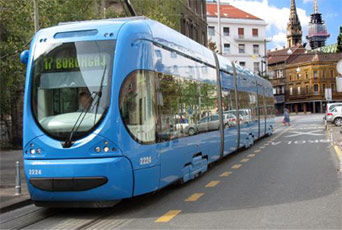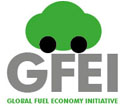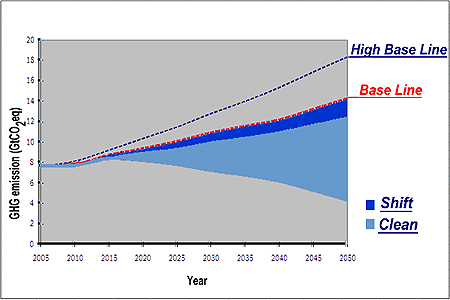
Flanking measures: complementing auto fuel efficiency initiatives
Non-motorized transportThe GFEI aims to facilitate large reductions of greenhouse gas emissions and oil use through improvements in automotive fuel economy in the face of rapidly growing car use worldwide. The initiative targets an improvement in average fuel economy (reduction in fuel consumption per kilometre) of at least 50% worldwide by 2050. With efficiency related complementary, or flanking, measures designed to shift personal mobility to less polluting and energy-intensive modes, this is likely to result in at least a stabilisation of CO2 emissions from the global car fleet.
Going beyond stabilization and reducing emissions below 2005 levels would require a combination of strong measures and support from policy makers. This could include, for example, achieving the 50% improvement in fuel economy of new vehicles globally by 2030 (or before) and maintaining progress beyond that target, e.g. via vehicle electrification and deploying other advanced technologies.
But further reductions will also require a variety of measures to help manage growth in travel demand, encourage modal shifts to more efficient modes like mass transit, non-motorized transport, and more efficient transport in urban areas through planning and smart growth.

The greatest and most cost-effective reductions in greenhouse gas emissions from road transport, according to International Energy Agency scenarios, will result from improved efficiency of transport modes. Modal shift options and alternative fuel options – part of the flanking measures – can make up the difference (see figure below).
The International Energy Agency’s Blue Shift scenario assumes that the demand for private mobility is reduced by a combination of the following:
- Better urban planning
- Infrastructure improvements
- Better public transit systems such as BRT, light rail and inter-city high-speed rail systems
- Policy measures that encourage use of these modes
In many countries, and especially in developing countries, clean, affordable and safe public transport is lacking, such as Bus Rapid Transit (BRT) systems, rail systems and facilities and infrastructure for non motorized transport. Without the development of efficient, affordable and clean public transport systems it is unlikely that the predicted rapid increase of personal vehicles, including 2 and 3 wheelers, will be avoided. Although the interest in public transport systems, especially BRT systems, is rising worldwide, with plans for new systems in Africa, Asia and Latin America, investment is still lacking.
Contribution of emissions reductions from baseline HGH scenarios to IEA Blue Map/Shift scenario (based on IEA 2009)This figure shows the GHG emissions reductions in the optimal International Energy Agency “Blue Map/Shift scenario” – cutting GHG emissions by 70% by 2050 compared to the baseline. While moving from the high baseline to the baseline will include a mix of measures, going below the baseline depends for a large part on increased efficiency – including second generation biofuels and more efficient vehicles (the light blue area marked as “Clean”)
Non-motorized transport
The facilitation of non-motorized transportation (NMT), i.e. walking or cycling, can help reduce the CO2 emissions from travel within urban areas – but the success of such modes of transportation requires having a long-term policy commitment to their development.
A 1% shift in distance undertaken by car to non-motorised transport reduces energy consumption and pollution emissions by 2–4%. Another study suggests that improved infrastructure leading to 2,500 people driving 5 fewer kilometres per day would save 1 kiloton of CO2 per day. The use of NMT results in reductions in noise, vibration and non-CO2 emissions, with tangible economic benefits derived from the increased productivity and reduced morbidity of an active, healthy population.
For example, footways and bicycle facilities should be regarded as safety features that also encourage active lifestyles, low-carbon travel and serve as community meeting places. Additionally, NMT infrastructure is also an investment for poverty reduction and economic development, as it enables the vast majority of citizens to access jobs, vital goods and services, not only via the current majority mode of transport but also through integration between modes, in particular public transport.
As transport modes, walking and cycling are extremely energy and cost effective. Few methods of reducing carbon emissions are as effective as substituting the automobile with a bicycle on short trips. In urban areas, distances of 3-5 km are ideal for trips on foot, bicycle or low-emission electrified transport (scooters, electric bikes, low emission vehicles). According to the IEA, "walking still is the widest used mode of transport in terms of trip share. But its share of distance travelled has declined very significantly during the last century as other faster modes of travel have grown. It is still today in most countries the most used mode for trips shorter than 3km."
NMT modes are well-supported by compact cities which tend to be more sustainable than sprawling cities. As a recent World Bank report states, “denser cities use less energy for transportation, with lower transport-related gas emissions, and are able to provide services at lower cost and can implement more energy-efficiency measures.”








